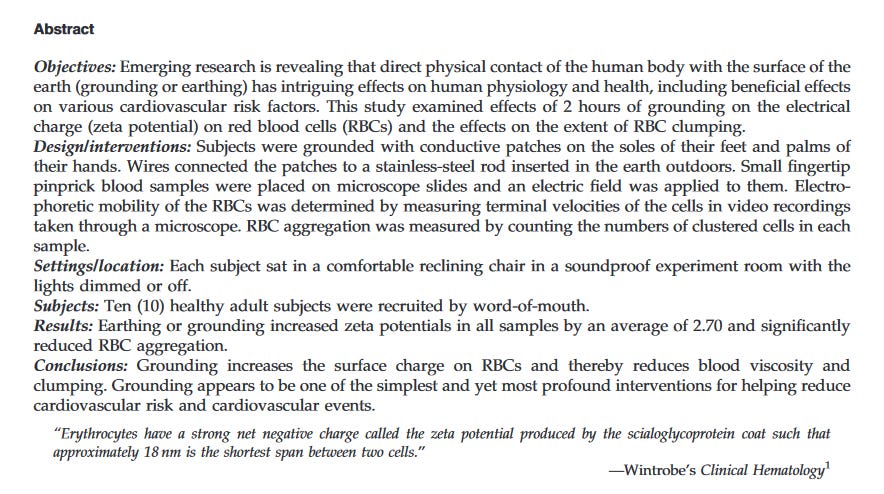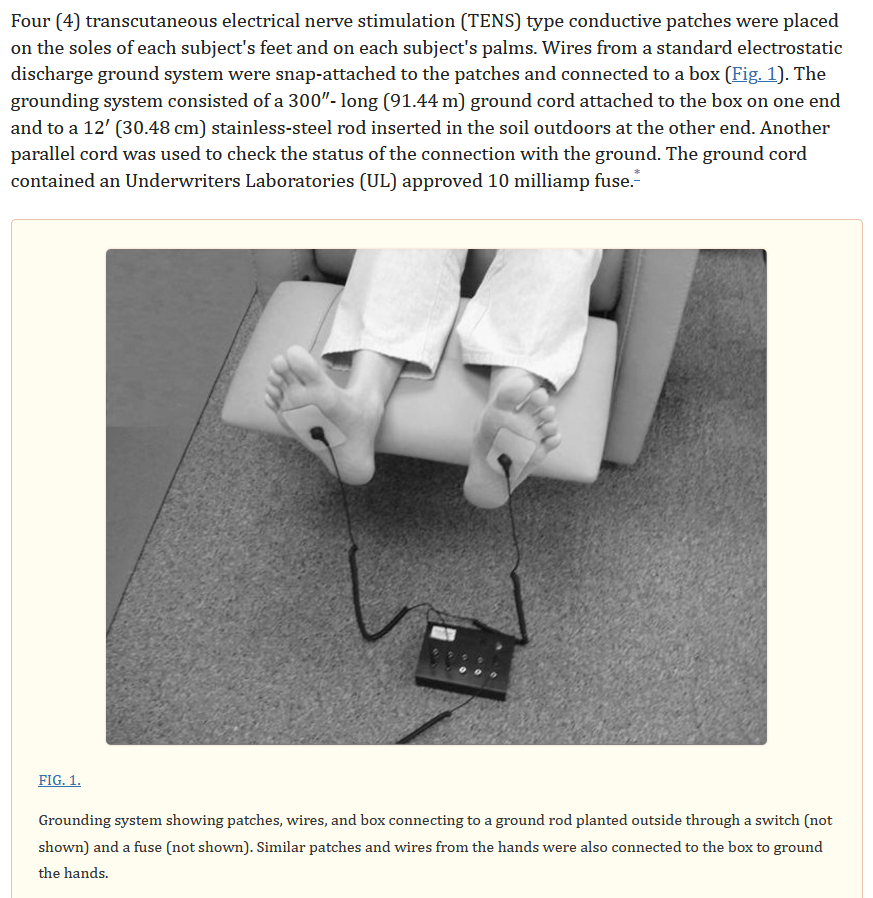Earthing (Grounding) the Human Body Reduces Blood Viscosity—a Major Factor in Cardiovascular Disease - Red Blood Cell Zeta Potential Increased by Factor 2.7!
Earthing (Grounding) the Human Body Reduces Blood Viscosity—a Major Factor in Cardiovascular Disease
I found this article on the relationship of grounding on blood viscosity. After I had spoken with Dr Pedro Chavez who mentioned to me that the MAC addresses emission of vaccinated patients was interrupted when walking barefoot I looked into grounding shoes. I have told the story that I did testing on Birkenstock shoes which have a cork and rubber sole - it really makes a difference, and that is all I wear anymore for me personally. I was so excited about this simple method I got Birkenstock’s for all my staff ( I have no affiliation with them, any other grounding shoes can be used) . I definitely have seen in my clinical practice significant improvement with telling my patients to ground. Some with extreme EMF sensitivity and autonomic dysfunction go outside, lay on the ground and can control their symptoms. Understanding now from the document yesterday of how we resonate with the Earth for healing purposes, this makes sense.
CIA Gateway paper human consciousness
1. Role of Resonance. However, brain coherence through entrainment to "beat" frequencies introduced via stereo headphones is only part of the reason why the Gateway system works. It is also designed to achieve the physical quietude characteristic of deep transcendental meditative states which brings about a complete alteration of the fundamental resonance pattern associated with the sound frequencies produced by the human body. Yoga, zen or transcendental meditation, if practiced long enough, will produce a change in the sound frequency with which the human heart resonates throughout the entire body. According to Bentov, this change in resonance results from elimination of what the medical profession calls "the bifurcation echo" so that the sound of the heartbeat can move synchronously up and down the circulatory system in harmonious resonance approximately seven times a second. Bentov describes the roll played by the bifurcation echo as follows: "When the left ventricle of the heart ejects blood, the aorta, being elastic, balloons out just beyond the valve and causes a pressure pulse to travel down along the aorta. When the pressure pulse reaches the bifurcation in the lower abdomen (which is where the aorta forks in two to go into the legs), part of the pressure pulse rebounds and starts traveling up the aorta. If in the meantime the heart ejects more blood, and a new pressure pulse is traveling down, these two pressure points will eventually collide somewhere along the aorta and produce an interference pattern." By placing the body in a sleeplike state, the Gateway tapes achieve the same goal as meditation in that it places the body in such a profoundly relaxed state that the bifurcation echo slowly fades away as the heart lessens the force and frequency with which it pushes blood into the aorta. The result is a regular, rhythmic sinewave pattern of sound which echoes throughout the body and rises up into the head in sustained resonance. The amplitude of this sinewave pattern, when measured with a sensitive, seismograph type instrument is about three times the average of the sound volume produced by the heart when it is operating normally.
I specifically wanted to mention again on how the body like a tuning fork attunes to the vibratory frequency of the earth.
1. Also, the brain is contained in a tight membrane called the dura which is, in turn, cushioned by a thin layer of fluid located between it and the skull. As the cohere t resonance produced by the human heart in a state of profound relaxation reaches the fluid layer surrounding the brain, it sets up a rhythmic pattern in which the brain moves up and down approximately 0.005 to 0.010 millimeters in a continuous pattern. The self reinforcing character of resonant behavior accounts for the body's ability to sustain this movement despite the minimal level of energy involved. In this way, the entire body, based on its own micromotion, functions as a tuned vibrational system which transfers energy in a range of between 6.8 and 7.5 Hertz into the earth's ionospheric cavity, which itself resonates at about 7-7.5 Hertz. Of this process, Bentov states:
"This is occurring at a very long wavelength of about 40,000 Km, or just about the perimeter of the planet. In other words, the signal from the movement of our bodies will travel around the world in about one seventh of a second through the electrostatic field in which we are imbedded. such a long wavelength knows no obstacles, and its strength does not attenuate much over large distances. Naturally it will go through just about anything: metal, concrete, water, and the fields making up our bodies. It is the ideal medium for conveying a telepathic signal."
With this in mind, lets go back to the Grounding article:
From the perspective of the health care practitioner, it is essential to have a better understanding of the relationships between other well-documented factors in CVD, including blood viscosity, blood pressure (BP), peripheral resistance, coagulation, left-ventricular hypertrophy, and inflammation.
Blood is a complex fluid containing a variety of formed elements (cells), proteins, nutrients, and metabolic waste products, along with dozens of clotting factors. In spite of this complexity, measurement of the electrophoretic mobility or zeta potential of red blood cells (RBCs) is a simple method for measuring blood viscosity.4–8 This is because blood viscosity is strongly influenced by the RBC surface charge that governs the spacing between erythrocytes. A higher repulsive surface charge increases spacing between erythrocytes, reduces clumping, lowers viscosity, and lowers peripheral resistance to flow.9 Conditions that reduce RBC surface charge correlate with occlusive arterial disease because of a higher incidence of RBC aggregation.5 It is accepted that blood viscosity and resistance to blood flow are related and are elevated in patients who have hypertension.10–12Total resistance is the product of vascular resistance and viscosity. Small changes in viscosity produce large differences in total resistance,13 especially in peripheral vessels <30 μm in diameter, in which the relative effective viscosity can increase six- to sevenfold.14 These results confirm the existence of a blood hyperviscosity syndrome in hypertension. Positive correlations in rheologic variables with arterial pressure and with indices of left-ventricular hypertrophy suggest that these changes may be involved in the pathophysiology of hypertension and its serious complications
The electrophoretic mobility or zeta potential can be measured by determining the mobility of RBCs in an imposed electric field. The classic text on zeta potential is Control of Colloid Stability Through Zeta Potential (with a closing chapter on its relationship to CVD by Riddick).4 Riddick's perspectives on CVD are important but have not been widely recognized, probably because rheology is a highly specialized and interdisciplinary subject. Moreover, blood is a very complex material, and many variables affect its ability to carry oxygen, nutrients, and metabolic waste products.
In this report the terms earthing and grounding are used interchangeably. The branch of physics known as electrostatics teaches that, when two conductive objects with different electrical potential touch each other, there is a virtually instantaneous transfer of charge so that the two objects equilibrate to the same electrical potential. The human body is a conductor of electricity17 and so is earth (soil), except in very dry areas such as deserts. Consequently, grounding leads to rapid equalization of the electrical potential of the body with the potential of the Earth (planet) through an almost instantaneous transfer of electrons from soil to the body.18,19 This has been the natural bioelectrical environment of the human body and of other organisms throughout most of evolutionary history.
Given that earthing or grounding alters many electrical properties of the body,18–21it was logical to evaluate an electrical property of the blood. The goal was to find if grounding affects RBC zeta potential and RBC aggregation in an ordinary office environment. The results show that grounding the body to soil increases the zeta potential and thereby decreases aggregation of RBCs.
Results
Zeta potential
Table 3 shows RBC velocity and zeta potential (ζ) before and after grounding (earthing) for each of the 10 subjects. As explained previously, for each blood draw, RBC velocity was measured 9 times. Given that there were 2 blood draws before and 2 blood draws after a session (for a total of 4 blood draws per subject per session), each RBC velocity presented in Table 3represents the average of 18 measurements. The average, SD and standard error of the mean (SEM) were computed between subjects. Thus, these statistical parameters reflected the distribution of velocities among subjects (which were consistent with a normal distribution according to the Lillifors test for normality). The zeta potentials in this table were computed using the Smoluchowski equation from the corresponding velocities (as previously explained). All subjects had an increase in the absolute value of zeta potential after 2 hours of grounding. The smallest absolute increase was by a factor of 1.27 and the largest was by a factor of 5.63. On average, the absolute value of zeta potential increased by a factor of 2.70 (a highly statistically significant result, as can be seen from the one-tailed t-test; this statistical test was used because an increase in the absolute value of zeta potential of ∼ 20%–30% was expected after grounding). This increase effectively brought the average zeta potential from a very small average value of −5.28 mV into a normal value (–14.3 mV). It seems that the healthier a subject was, the less significant the increase was
RBC aggregation
With respect to RBC aggregation results for the 10 subjects, there were significantly more aggregates or (clusters) during grounding (after 2 hours of grounding while still grounded) than before grounding (p=0.0000153). This is because there were significantly more clusters with 1 or 2 cells after 2 hours of grounding (p=0.0000269 and p=0.000354, respectively), simultaneously significantly fewer clusters of 3 cells (p=0.0451), and far fewer clusters with 4+ cells (although no statistical evaluation was done for clusters with 4+ cells, the last column of Table 4shows that the average number of cells during earthing, which was 15.0, was less than half the average number of cells before earthing which was 34.7, a ratio of 34.7/15.0=2.3>2.0). There was clearly less clumping after 2 hours of grounding than before grounding.
Discussion
A number of clinical studies on the physiologic effects of grounding the human body have indicated improvements in various cardiovascular and heart-related parameters. One of the first investigations reported normalization of the day–night cortisol rhythms in subjects who were grounded by sleeping on a conductive mattress pad connected via a wire to a rod inserted into soil.31 It is known that chronic elevation of cortisol can result in disruption of circadian rhythms and chronic activation of the sympathetic nervous system, both of which can contribute to insomnia and its many well-documented health effects, including hypertension, CVD, stroke and other disorders.32,33
Subsequent research has repeatedly confirmed the positive effects of grounding on the autonomic nervous system (ANS), including increases in parasympathetic activity18,34 and, most recently, increases in heart rate variability (HRV).35 The significance of the latter study is that HRV is an important indicator of the status of autonomic balance and stress on the cardiovascular system. A decrease in HRV indicates autonomic dysfunction and is a predictor of the severity of progression of coronary artery disease.36,37 The positive effects of grounding on HRV suggest that simple grounding techniques can be utilized as a basic strategy for supporting the cardiovascular system, especially during situations of heightened autonomic tone and/or hypertension.35 The present study demonstrated a profound increase in zeta potential and a corresponding decrease in blood viscosity.
Magnets repel each other when the same poles come sufficiently close to one another. Similarly, electric charges of the same sign repel each other when they are in proximity to one another. The surface of RBCs has negative electrical charges that maintain spacing of the cells in the bloodstream by electrostatic repulsion. The electrophoretic mobility of RBCs is a function of net negative charge (zeta potential), provided that the viscosity of the suspending medium does not change during the measurement. In a study of 50 patients with occlusive arterial disease and 50 control counterparts (N=100), the migration time of red cells (seconds) was longer and the electrophoretic mobility (μsec/V/cm) was less in the patients with occlusive disease than in the healthy controls.5 This study on electrophoretic mobility suggested differences in RBC surface charge (zeta potential). The researchers concluded that patients with occlusive arterial disease have one or more factors in their plasma and RBCs that reduce the net negative charge (zeta potential) of the cells, thereby facilitating RBC aggregation.5 This finding supports the notion that there are definitely many factors that can reduce zeta potential, and thereby increase blood viscosity and increase RBC aggregation, both of which play a major role in the pathogenesis of arteriosclerosis.5 A meta-analysis evaluating the connection between blood viscosity and CVD demonstrates clearly that the risk of major cardiovascular events increase with higher blood-viscosity levels.38 In the Edinburgh Artery Study, a population of 4860 men 45–59 years of age was observed for 5 years. The 20% of the men with the highest blood viscosity had a 3.2 times greater risk for cardiac events, compared with the 20% of men with the lowest blood viscosity. Fifty-five percent (55%) of major cardiovascular events occurred in the highest blood-viscosity group versus only 4% in the lowest blood-viscosity group.39
Summary:
Earthing has significantly beneficial effects on blood viscosity, improves zeta potential, reduces blood clumping, heart rate variability, autonomic function, decreases pain and walking barefoot or with grounding shoes of your preference is a cheap and simple method to help the body recover from this assault. Other options like earthing mats can also be explored for health benefits. Also considering how our body is like a vibrational tuning fork connected with the vibratory frequency of the earth, other effects on spiritual clarity, and calming down the nervous system could also be considered. All around - it works.




No comments:
Post a Comment